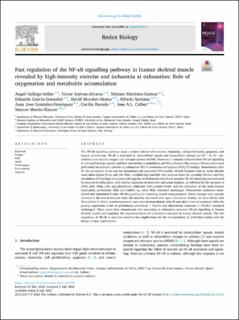| dc.contributor.author | Gallego-Selles, Angel | |
| dc.contributor.author | Galvan-Alvarez, Victor | |
| dc.contributor.author | Martinez-Canton, Miriam | |
| dc.contributor.author | Garcia-Gonzalez, Eduardo | |
| dc.contributor.author | Morales-Alamo, David | |
| dc.contributor.author | Santana, Alfredo | |
| dc.contributor.author | Gonzalez-Henriquez, Juan Jose | |
| dc.contributor.author | Dorado, Cecilia | |
| dc.contributor.author | Calbet, Jose Antonio Lopez | |
| dc.contributor.author | Martin-Rincon, Marcos | |
| dc.date.accessioned | 2022-12-01T10:10:59Z | |
| dc.date.available | 2022-12-01T10:10:59Z | |
| dc.date.created | 2022-08-16T09:50:15Z | |
| dc.date.issued | 2022 | |
| dc.identifier.citation | Redox Biology. 2022, 55(September 2022), Artikkel 102398. | en_US |
| dc.identifier.issn | 2213-2317 | |
| dc.identifier.uri | https://hdl.handle.net/11250/3035260 | |
| dc.description | This is an open access article under the CC BY license (http://creativecommons.org/licenses/by/4.0/). | en_US |
| dc.description.abstract | The NF-κB signalling pathway plays a critical role in inflammation, immunity, cell proliferation, apoptosis, and muscle metabolism. NF-κB is activated by extracellular signals and intracellular changes in Ca2+, Pi, H+, metabolites and reactive oxygen and nitrogen species (RONS). However, it remains unknown how NF-κB signalling is activated during exercise and how metabolite accumulation and PO2 influence this process. Eleven active men performed incremental exercise to exhaustion (IE) in normoxia and hypoxia (PIO2:73 mmHg). Immediately after IE, the circulation of one leg was instantaneously occluded (300 mmHg). Muscle biopsies from m. vastus lateralis were taken before (Pre), and 10s (Post, occluded leg) and 60s after exercise from the occluded (Oc1m) and free circulation (FC1m) legs simultaneously together with femoral vein blood samples. NF-κB signalling was activated by exercise to exhaustion, with similar responses in normoxia and acute hypoxia, as reflected by the increase of p105, p50, IKKα, IκBβ and glutathione reductase (GR) protein levels, and the activation of the main kinases implicated, particularly IKKα and CaMKII δD, while IKKβ remained unchanged. Postexercise ischaemia maintained and stimulated further NF-κB signalling by impeding muscle reoxygenation. These changes were quickly reverted at the end of exercise when the muscles recovered with open circulation. Finally, we have shown that Thioredoxin 1 (Trx1) protein expression was reduced immediately after IE and after 1 min of occlusion while the protein expression levels of glutathione peroxidase 1 (Gpx1) and thioredoxin reductase 1 (TrxR1) remained unchanged. These novel data demonstrate that exercising to exhaustion activates NF-κB signalling in human skeletal muscle and regulates the expression levels of antioxidant enzymes in human skeletal muscle. The fast regulation of NF-κB at exercise cessation has implications for the interpretation of published studies and the design of new experiments. | en_US |
| dc.language.iso | eng | en_US |
| dc.subject | fatigue | en_US |
| dc.subject | free radicals | en_US |
| dc.subject | hypoxia | en_US |
| dc.subject | NFĸB | en_US |
| dc.subject | performance | en_US |
| dc.subject | ROS | en_US |
| dc.title | Fast regulation of the NF-κB signalling pathway in human skeletal muscle revealed by high-intensity exercise and ischaemia at exhaustion: Role of oxygenation and metabolite accumulation | en_US |
| dc.type | Peer reviewed | en_US |
| dc.type | Journal article | en_US |
| dc.description.version | publishedVersion | en_US |
| dc.rights.holder | © 2022 The Authors | en_US |
| dc.source.pagenumber | 17 | en_US |
| dc.source.volume | 55 | en_US |
| dc.source.journal | Redox Biology | en_US |
| dc.identifier.doi | 10.1016/j.redox.2022.102398 | |
| dc.identifier.cristin | 2043291 | |
| dc.description.localcode | Institutt for fysisk prestasjonsevne / Department of Physical Performance | en_US |
| dc.source.articlenumber | 102398 | en_US |
| cristin.ispublished | true | |
| cristin.fulltext | original | |
| cristin.qualitycode | 1 | |


